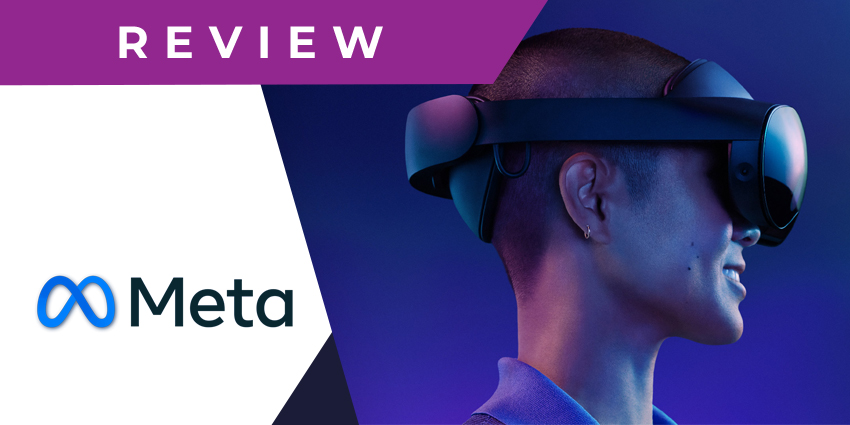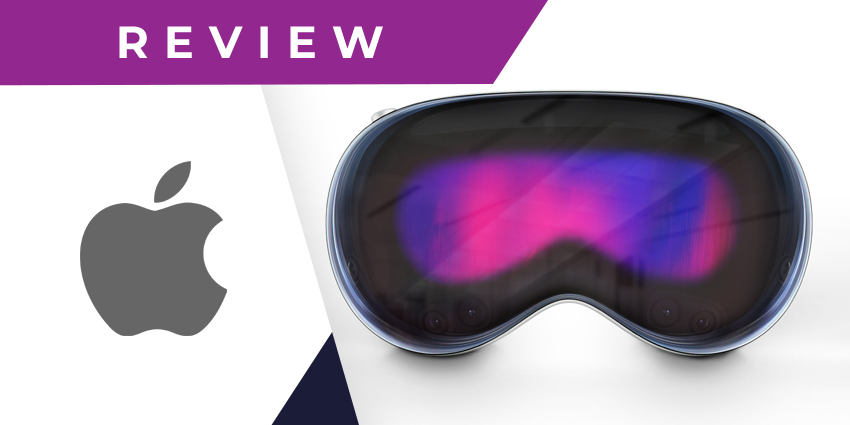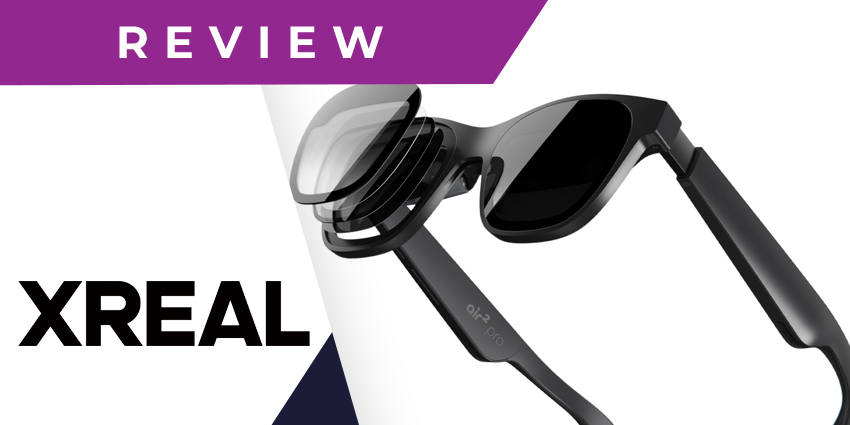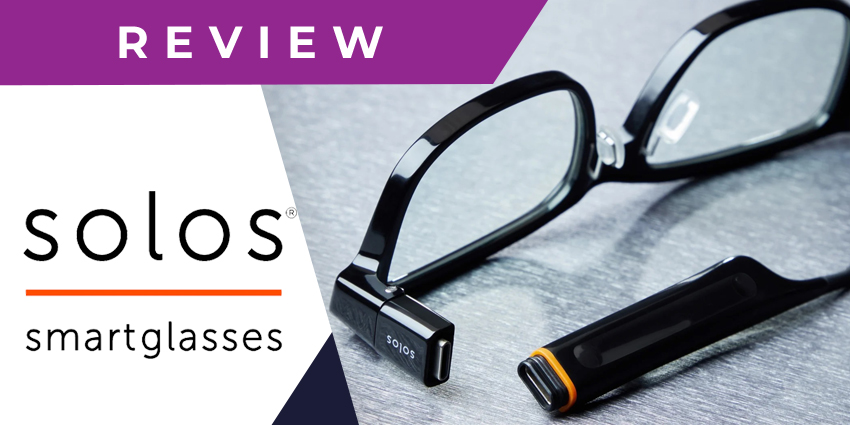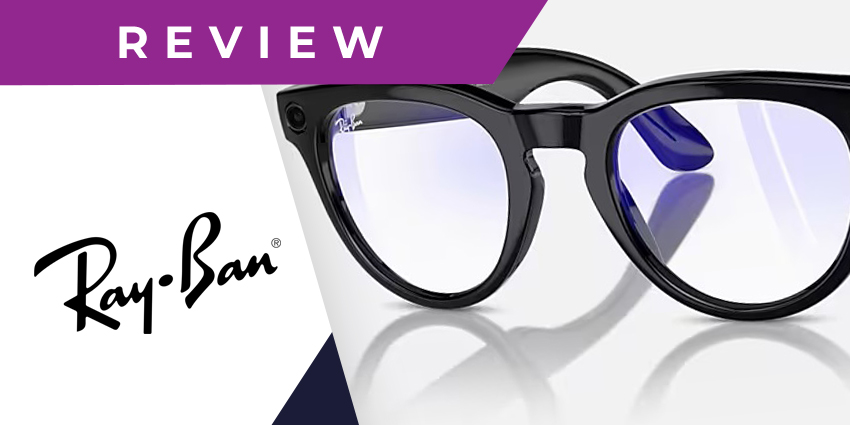In this Meta Quest Pro review, we’re taking a hands-on look at Meta’s enterprise-grade VR (and mixed reality) headset, designed for business users.
Defined as Meta’s “premium” headset for metaverse explorers, the Pro was designed to elevate Meta from a consumer-focused headset vendor to a competitor in the enterprise space. That move makes sense as more vendors recognize the demand for VR in the commercial landscape.
In the last year, many companies have created enterprise-focused headsets for collaboration, product development, training, and more. Even Apple seems to focus on the business world with its pricey Apple Vision Pro.
While the Meta Quest Pro offered a big step up to the Quest 2 when launched in October 2022, the arrival of the Quest 3, with features that outshine the Pro in certain areas and a lower price tag, has left business leaders wondering whether the premium headset is worthwhile.
Here’s everything you need to know about the Meta Quest Pro.
Meta Quest Pro Review: Introduction and Specs
The Meta Quest Pro marked Meta’s first steps into the world of business-focused extended reality. Before this, Meta’s headsets were considered accessible, intuitive, and affordable options for consumers. However, increasing demand for enterprise-level solutions pushed Meta, alongside many other vendors, to expand its portfolio.
The Quest Pro has a higher price tag than the Quest 2 and the new Meta Quest 3. However, it still represents a relatively affordable enterprise-grade option, with prices starting at $999. Remember, alternatives like the Apple Vision Pro are set to cost almost four times as much ($3,499).
Unfortunately, the lower price tag does mean the Pro doesn’t have the most impressive specs on the market. But it’s still reasonably impressive:
| Chipset | Qualcomm Snapdragon XR2 |
| Resolution | 1832×1920 per eye |
| RAM | 12GB |
| Storage | 256GB |
| Battery | 2-3 hours |
| Weight | 1.59 pounds |
| Mixed Reality | Full-color passthrough |
| OS | Android |
| IPD | 55-75 mm |
| Audio | Integrated speakers and microphone (spatial audio) |
| Connectivity | Wi-Fi 6E and Bluetooth 5.2 |
The Meta Quest Pro has numerous optional accessories from Amazon, the Meta online store, and other vendors. Plus, it’s compatible with the Meta Quest for Business subscription service, announced by Meta in 2023.
Meta Quest Pro Review: Availability and Pricing
As mentioned at the beginning of this Meta Quest Pro review, the Meta lineup has evolved to include the Meta Quest 3 in the last year. As a result, Meta has reduced the price of some of its previous headsets in certain regions. When the Quest Pro was first launched, it had a price tag of around $1,499. Now, you can access the Pro for as little as $999.
This price includes Meta’s more advanced “Touch Plus” controllers, eliminating the tracking rings from the Quest 2 versions. You also get wrist straps, a charging dock, and a protective cover for your headset.
Design and Comfort
Most of Meta’s headsets have featured similar designs, featuring a lot of white plastic. The Meta Quest Pro is slightly different, with a sleeker all-black finish. We were impressed by the overall appearance and feel of the headset. The device is relatively lightweight, weighing around 1.59 pounds.
This makes it a slightly more comfortable solution than some of the bulkier enterprise-grade headsets available. There are no wires to get in the way of your experience and very few buttons on the headset itself. There’s a front dial to adjust the interpupillary distance and improve the overall fit. Plus, you get a dial to adjust the position of the strap for more stability.
The headset includes pancake lenses in the front, which help enhance visual quality, and three forward-facing cameras, plus two side-facing cameras for passthrough mode. There’s also an integrated set of speakers and a microphone for communication.
One odd thing we did notice during this Meta Quest Pro review is that the device doesn’t include any extra padding to protect your face and block out external light. There are shields to help improve immersion, but light can leak through from your surroundings.
You can also purchase optional accessories, like the Full Light Blocker, which fits magnetically against the mask section for extra padding and light isolation. This accessory effectively improves comfort, particularly for those suffering from VR sickness.
Meta Quest Pro Review: The Controllers
As noted in other enterprise-grade headset reviews, controllers can make a big difference to the level of immersion you feel in virtual reality. Compared to Meta’s Quest 2 controllers, with their tracking rings, the Meta Quest Touch Pro controllers (and stylus tips) are a vast improvement.
These controllers feel much more ergonomic, similar to the experience with the Meta Quest 3. They also feature advanced TruTouch Haptics for better feedback when interacting with digital objects. The controllers have self-tracking technology and offer a full 360-degree range of motion.
Plus, the attachable stylus tips are excellent for precision in complex activities. For instance, you can write on virtual surfaces, which could be ideal for immersive collaboration sessions. You can feel the pressure of surfaces when writing on a whiteboard or wall.
Notably, Meta does offer some spatial tracking capabilities in its headset, too, so you’re not constantly reliant on the controllers for everything you do. Some features allow you to interact with certain apps through gestures or using your voice.
However, if you will be using the controllers regularly, we think the Touch Pro’s are intuitive, comfortable, and very easy to use. You can almost forget you’re using them.
Ease of Use and Setting Up
During our Meta Quest Pro review, we were pretty impressed by how intuitive the overall experience is for beginners. If you’re diving into the extended reality world for the first time, for collaboration or training purposes, you shouldn’t have any issues.
Once you put on the device and adjust it to your needs, you can simply switch the headset on and receive easy-to-follow instructions on how to get started. The Meta Quest Pro’s open-sided design and color-passthrough features shine through here.
You can use the device in any environment, even a cluttered office, without worrying about bumping into anything. All you need to do is ensure you have enough space to move your arms around freely. You’ll also need to connect your device to the internet.
Fortunately, the Wi-Fi 6E functionality is very impressive, and you’ll immediately see a virtual window listing the networks you can access during the configuration process.
Meta Quest Pro Review: Visuals and Performance
Although the Meta Quest Pro doesn’t offer the same visual clarity as some more expensive headsets we’ve reviewed, such as the Pimax Reality 12k, it’s still a significant upgrade from the Quest 2. You get fantastic pancake optics, delivering 1832×1920 resolution per eye. Plus, there’s an excellent refresh rate of up to 90hz, so you’ll have minimum lag.
Notably, however, the visuals aren’t quite as impressive as those on the cheaper Meta Quest 3, which boasts 2064×2208 resolution for each eye and a refresh rate of up to 120Hz.
Additionally, the chipset is a little older than the one on the Quest 3 but still impressive. During our Meta Quest Pro review, we were delighted by the ultra-fast performance of the Snapdragon XR2+ platform. It ensures the headset can operate up to 50% faster than the Quest 2.
You also get 12GB of RAM and up to 256GB of storage. One particularly impressive thing about the Quest Pro’s performance is the integrated eye-tracking capabilities, which allow for foveated rendering. This ensures you can make the most of your battery life and processing power, as it renders the pixels in front of your eyes with more detail.
Mixed Reality Capabilities
When it was first announced, one of the biggest selling points of the Meta Quest Pro was the addition of advanced mixed reality capabilities. The previous Meta Quest 2 supported black-and-white passthrough. However, the Pro takes this functionality to the next level with a full-color passthrough.
The cameras built into the headset ensure you can see the world around you reasonably well. It’s not the same as looking at your surroundings directly, however. There’s still some graininess to overcome here. However, it’s much better than what you get on the Quest 2.
However, unlike the Meta Quest 3, the Quest Pro is more of a virtual reality-focused solution, with mixed reality options. The Quest 3 has a lot more pixel density in its passthrough mode than the Pro, which might make it a better choice for those exploring new extended reality worlds.
Additionally, it’s worth noting the Quest Pro was initially supposed to include a depth sensor, which would have allowed the solution to map the physical space around you more effectively. Meta ultimately scrapped this feature. However, the company has announced its plans to update the hand-tracking and eye-tracking capabilities in the Pro going forward.
Meta Quest Pro Review: Audio and Battery Life
When we first tested the Pro, before this comprehensive Meta Quest Pro review, the audio seemed a lot more impressive. The solution has built-in speakers that deliver relatively loud and crisp audio. Plus, it supports positional audio (spatial audio). This means you can hear sounds coming from different directions around you – ideal for meetings.
However, the Pro feels a little lacking compared to the Quest 3 audio experience. The sound might be clear, but there’s not a lot of depth to what you get. Fortunately, there is a headphone jack, so you can plug in your headphones if necessary.
One potential major downside of the Quest Pro is its limited battery life. While the company promised a 2-3 hour battery life, the Quest Pro usually only works for around 1-2 hours (in our experience), depending on the apps you’re using.
However, you can check the battery life at any time in the Quest app settings or on the home menu. Plus, you can connect the headset to an outlet via a power cable, leading to a slightly clunkier experience. Notably, it takes about 2 hours to charge the Quest Pro, too, so it’s worth ensuring you have your charging cradle handy after each session.
The App and Software Experience
We expected to have no problems with the software during our Meta Quest Pro review, and we were right. Meta has a fantastic selection of apps and tools on its app store. It can work with numerous business-focused solutions, including Adobe Acrobat and Smartsheet.
Plus, you can use it to navigate solutions like Microsoft Teams’ Immersive Spaces or Horizon Workrooms. Notably, some of the app experiences feel a little clunky, such as when setting up your workroom in Horizon. However, the overall experience is good, offering an easy way to dive into immersive collaboration sessions.
Horizon Worlds seems to work particularly well with the Meta Quest Pro. If you’re interested in exploring the metaverse to attend virtual events or watch immersive videos, you’ll have no problems here. Moving around in virtual environments feels simple and intuitive, and the high-quality visuals allow for a comfortable overall experience.
Meta Quest Pro Review: The Final Verdict
Overall, our hands-on Meta Quest Pro review revealed that the Pro is still valuable for enterprise users entering the metaverse. It might fall behind the Meta Quest 3 in some areas and lack the advanced features of new and upcoming MR headsets, but it’s still a great system.
The headset does a great job of tracking facial expressions, hand gestures, and other details. The built-in color passthrough allows for a great (albeit basic) mixed reality experience. Moreover, thanks to its reduced price tag, we think the Meta Quest Pro will likely be an attractive option for more companies in the years ahead.
It could be an excellent mid-range headset for companies looking to leverage the benefits of the metaverse without spending a fortune on hardware. If Meta continues to build on the headset’s functionality with software and firmware updates, we can see the device staying competitive – even with the arrival of the Meta Quest 3.
Pros:
- Excellent eye and face tracking technology
- Impressive controllers with haptic feedback
- Decent color passthrough capabilities
- Great wireless experience
- Easy set-up and management for beginners
- High-quality visuals and spatial audio
Cons:
- Limited battery life
- It lacks some features of the Meta Quest 3
- Sound quality could be improved
